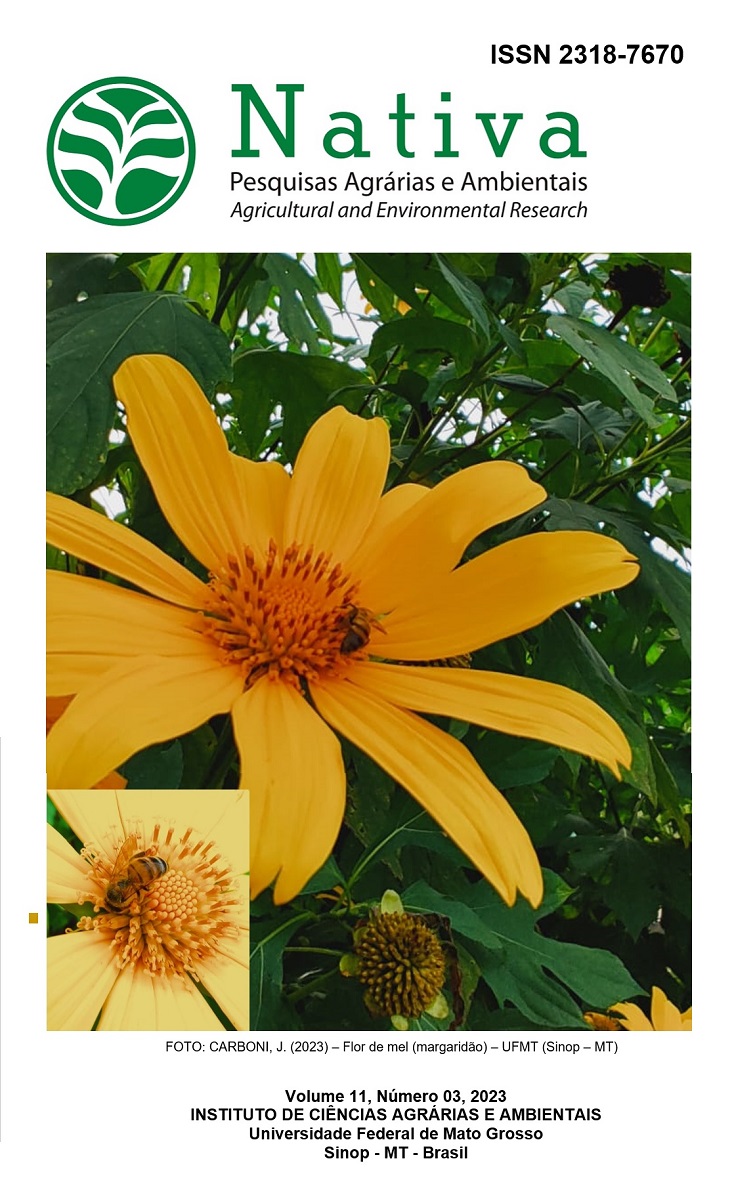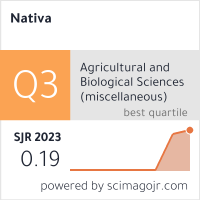ÍNDICES DE COMPETIÇÃO INDEPENDENTES DA DISTÂNCIA EM UM FRAGMENTO DE MATA ATLÂNTICA
DOI:
https://doi.org/10.31413/nat.v11i3.14821Palavras-chave:
altura de árvores, competitividade, comportamento sigmoidal, relação funcionalResumo
Investigações científicas sobre o comportamento de índices de competição em diferentes estratos de altura são escassas e podem subsidiar o desenvolvimento de planos, manutenção e monitoramento para a recuperação de áreas degradadas e contribuir para o desenvolvimento de futuras pesquisas sobre a dinâmica de crescimento em povoamentos inequiâneos. O objetivo do presente trabalho foi avaliar a influência de índices de competição independentes da distância no comportamento biométrico de árvores em diferentes estratos de altura em um fragmento de Mata Atlântica sob recuperação florestal. O estudo foi conduzido em uma área de 2,53ha, onde se realizou o inventário com intensidade amostral de 15,81%. Calcularam-se seis índices de competição para árvores contidas nos estratos inferior, médio e superior do fragmento. Os índices cujos menores valores representam maior competição sobre a árvore-objetivo exibiram correlação positiva e se associaram melhor com os atributos biométricos. O comportamento de aspectos biométricos em relação à competitividade da árvore-objetivo foi distinto entre estratos de altura. Conclui-se que, para o local de estudo, o índice de IC2 demonstrou flexibilidade para analises sobre relações entre a competitividade e aspectos biométricos em distintos estratos de altura. Aspectos os biométricos lenhosos aumentam assintoticamente com a redução da competição sobre a árvore-objetivo.
Palavras-chave: altura de árvores; competitividade; comportamento sigmoidal; relação funcional.
Distance-independent competition indices in an Atlantic Forest fragment
ABSTRACT: Scientific investigations on the behavior of competition indices in different height strata are scarce and can subsidize the development of plans, maintenance and monitoring for the degraded area recovery and contribute to the development of future research on growth dynamics in uneven stands. This work aimed to evaluate the influence of distance-independent competition indices on the biometric behavior of trees in different height strata within an Atlantic Forest fragment under forest recovery. This study was conducted in an area of 2.53ha, where inventory was carried out with a sampling intensity of 15.81%. Six competition indices were calculated for trees contained in the lower, middle and upper strata of the fragment. Indices whose lower values represent greater competition on the target tree exhibited a positive correlation and had a better association with the biometric attributes. The behavior of biometric aspects regarding the competitiveness of the target tree was different between height strata. It is concluded that, for the study site, IC2 competition index demonstrated flexibility for analyzing relationships between competitiveness and biometric aspects in different height strata. Woody biometrics aspects increase asymptotically with reduced competition over the target tree.
Keywords: tree height; competitiveness; sigmoidal behavior; functional relationship.
Referências
BIANCHI, S.; HUUSKONEN, S.; SIIPILEHTO, J.; HYNYNEN, J. Differences in tree growth of Norway spruce under rotation forestry and continuous cover forestry. Forest Ecology and Management, v. 458, p. e117689, 2020. https://doi.org/10.1016/j.foreco.2019.117689
CAMPOS, J. C. C.; LEITE, H. G. Mensuração florestal: perguntas e respostas. 5 ed. Viçosa: Editora UFV, 2017. 636p.
CAO, L.; COOPS, N. C.; SUN, Y.; RUAN, H.; WANG, G.; DAI, J.; SHE, G. Estimating canopy structure and biomass in bamboo forest using airborne LiDAR data. ISPRS Journal of Photogrammetry and Remote Sensing, v. 148, p. 114-129, 2019. https://doi.org/10.1016/j.isprsjprs.2018.12.006
CASTRO, R.; SOARES, C.; LEITE, H. G.; SOUZA, A.; MARTINS, F.; NOGUEIRA, G. S.; SILVA, M. O. F. Competição em nível de árvore individual em uma floresta estacional semidecidual. Silva Lusitana, v. 22, n. 1, p. 43-66, 2014.
CLIMATE-DATA.ORG. Clima: São João Evangelista. Disponível em: <https://pt.climate-data.org/location/175926/>. Acesso em: 25 ago 2023.
CONAMA_Conselho Nacional do Meio Ambiente. Portaria nº 392, de 25 de junho de 2007. Definição de vegetação primária e secundária de regeneração de Mata Atlântica no Estado de Minas Gerais. Disponível em: <http://www.siam.mg.gov.br/sla/download.pdf?idNorma=6991>. Acesso em: 25 ago 2023.
CURTO, R. D. A.; MATTOS, P. P.; BRAZ, E. M.; CANETTI, A.; PÉLLICO NETTO, S. Effectiveness of competition indices for understanding growth in an overstocked stand. Forest Ecology and Management, v. 477, e118472, 2020. https://doi.org/10.1016/j.foreco.2020.118472
FISCHER, R.; KNAPP, N.; BOHN, F. J.; SHUGART, H. H.; HUTH, A. The relevance of forest structure for biomass and productivity in temperate forests: new perspectives for remote sensing. Surveys in Geophysics, v. 40, P. 709-734, 2019. https://doi.org/10.1007/s10712-019-09519-x
FUKUMOTO, K.; NISHIZONO, T.; KITAHARA, F.; HOSODA, K. Evaluation of individual distance-independent diameter growth models for Japanese cedar (Cryptomeria japonica) trees under multiple thinning treatments. Forests, v. 11, n. 3, p. 1-13, 2020. https://doi.org/10.3390/f11030344
CETEC_Fundação Centro Tecnológico de Minas Gerais. Desenvolvimento de equações volumétricas aplicáveis ao manejo sustentado de florestas nativas do estado de Minas Gerais e outras regiões do país. Belo Horizonte: CETEC, 1995. 295p.
GLOVER, G. R.; HOOL, J. N. A basal area ratio predictor of loblolly pine plantation mortality. Forest Science, v. 25, n. 2, p. 275-282, 1979. https://doi.org/10.1093/forestscience/25.2.275
HAMMER, B.; FRASCO, M. Metrics: evaluation metrics for machine learning. Disponível em: <https://CRAN.R-project.org/package=Metrics>. Acesso em: 25 ago 2023.
HILL, S.; LATIFI, H.; HEURICH, M.; MÜLLER, J. Individual-tree and stand-based development following natural disturbance in a heterogeneously structure forest: a LiDAR-based approach. Ecological Informatics, v. 38, p. 12-25, 2016. https://doi.org/10.1016/j.ecoinf.2016.12.004
HUI, G.; ZHANG, G.; ZHAO, Z.; YANG, A. Methods of forest structure research: a review. Current Forestry Reports, v. 5, p. 142-154, 2019. https://doi.org/10.1007/s40725-019-00090-7
KRŮČEK, M.; TROCHTA, J.; CIBULKA, M.; KRÁL, K. Beyond the cones: how crown shape plasticity alters aboveground competition for space and light – evidence from terrestrial laser scanning. Agricultural and Forest Meteorology, v. 264, p. 188-199, 2019. https://doi.org/10.1016/j.agrformet.2018.09.016
LHOTKA, J. M.; LOEWENSTEIN, E. F. An individual-tree diameter growth model for managed uneven-aged oak-shortleaf pine stands in the Ozark Highlands of Missouri, USA. Forest Ecology and Management, v. 261, n. 3, p. 770-778, 2011. https://doi.org/10.1016/j.foreco.2010.12.008
LAFETÁ, B. O.; MADUREIRA, N. F. S.; SANTOS, M. A.; PIMENTA, I. A.; BARBOSA, G. P.; FONTAN, I. C. I.; VIEIRA, D. Raio de competição entre árvores em um fragmento de Mata Atlântica sob recuperação florestal. Revista Forestal Mesoamericana Kurú, v. 20, n. 47, p. 55-62, 2023. https://10.18845/rfmk.v20i47.6823
LORIMER, C. G. Tests of age-independent competition indices for individual trees in natural hardwood stands. Forest Ecology and Management, v. 6, p. 343-360, 1983. https://doi.org/10.1016/0378-1127(83)90042-7
LUSTOSA JÚNIOR, I. M.; CASTRO, R. C. O.; GASPAR, R. O.; ARAÚJO, J. B. C. N.; AQUINO, F. G. Competition indexes to evaluate tree growth in a semi-deciduous seasonal forest. Floresta e Ambiente, v. 26, n. 4, p. 1-12, 2019. https://doi.org/10.1590/2179-8087.010716
MA, Q.; SU, Y.; TAO, S.; GUO, Q. Quantifying individual tree growth and tree competition using bi-temporal airborne laser scanning data: a case study in the Sierra Nevada Mountains, California. International Journal of Digital Earth, v. 11, n. 5, p. 485-503, 2017. https://doi.org/10.1080/17538947.2017.1336578
MENSAH, S.; TOIT, B.; SEIFERT, T. Diversity–biomass relationship across forest layers: implications for niche complementarity and selection effects. Oecologia, v. 187, p 783-795, 2018. https://doi.org/10.1007/s00442-018-4144-0
MINATTI, M.; SANQUETTA, C. R.; NETTO, S. P.; CORTE, A. P. D. Índices de competição dependentes da distância para Araucaria angustifólia em São João do Triunfo – PR. Brazilian Journal of Biosystems Engineering, v. 13, n. 3, p. 187-194, 2019. https://doi.org/10.18011/bioeng2019v13n3p187-194
R CORE TEAM. R: A language and environment for statistical computing. Vienna: R Foundation for Statistical Computing. 2022.
RODRÍGUEZ-RONDEROS, M. E.; BOHRER, G.; SANCHEZ-AZOFEIFA, A.; POWERS, J. S.; SCHNITZER, S. A. Contribution of lianas to plant area index and canopy structure in a Panamanian forest. Ecology, v. 97, n. 12, p. 3271-3277, 2016. https://doi.org/10.1002/ecy.1597
SCHONS, C. T.; FIGUEIREDO FILHO, A.; SANTOS, T. L.; NASCIMENTO, R. G. M. Índices de competição em nível de árvore individual para espécies da floresta ombrófila mista. Scientia Forestalis, v. 48, n. 128, e3275, 2020. https://doi.org/10.18671/scifor.v48n128.13
SCOLFORO, J. R. S.; THIERSCH, C. R. Biometria Florestal: medição, volumetria e gravimetria. Lavras: UFLA/FAEPE. 2004. 285p.
SIRAMI, E. V.; MARSONO, D.; SADONO, R.; IMRON, M. A. Ideal planting space for merbau (Intsia bijuga) forest plantations in Papua based on distance-dependent competition. Biodiversitas, v. 19, n. 6, p. 2219-2231, 2018. https://doi.org/10.13057/biodiv/d190630
STAGE, A. R. Prognosis model for stand development (Research Paper, No. INT-137). Madison: USDA Forest Service, 1973. http://dx.doi.org/10.5962/bhl.title.69018
SUMNALL, M.; FOX, T. R.; WYNNE, R. H.; THOMAS, V. A. Mapping the height and spatial cover of features beneath the forest canopy at small-scales using airborne scanning discrete return Lidar. ISPRS Journal of Photogrammetry and Remote Sensing, v. 133, p. 186-200, 2017. https://doi.org/10.1016/j.isprsjprs.2017.10.002
TAIZ, L.; ZEIGER, E.; MOLLER, I.; MURPHY, A. Fisiologia e desenvolvimento vegetal. 6 ed. Porto Alegre: Artmed, 2017. 888p.
TENZIN, J.; TENZIN, K.; HASENAUER, H. Individual tree basal area increment models for broadleaved forests in Bhutan. Forestry, v. 90, p. 367-380, 2017. https://doi.org/10.1093/forestry/cpw065
THOM, D.; KEETON, W. S. Stand structure drives disparities in carbon storage in northern hardwood-conifer forests. Forest Ecology and Management, v. 442, p. 10-20, 2019. https://doi.org/10.1016/j.foreco.2019.03.053
TOMÉ, M.; BURKHART, H. E. Distance-dependent competition measures for predicting growth of individual trees. Forest Science, v. 35, n. 3, p. 816-831, 1989. https://doi.org/10.1093/forestscience/35.3.816
TRINDADE, R. N. R.; LAFETÁ, B. O.; AGUIAR, V. F.; SILVA, A. G.; FERRARO, A. C.; PENIDO, T. M. A.; VIEIRA, D. S. Morfometria da copa de povoamentos de Eucalyptus grandis Hill ex Maiden × E. urophylla S. T. Blake em diferentes espaçamentos de plantio. Scientia Forestalis, v. 47, n. 121, p. 83-91, 2019. https://dx.doi.org/10.18671/scifor.v47n121.08
VERSACE, S.; GIANELLE, D.; FRIZZERA, L.; TOGNETTI, R.; GARFI, V.; DALPONTE, M. Prediction of competition indices in a Norway spruce and silver fir-dominated forest using LiDAR data. Remote Sensing, v. 11, p. 18, 2019. https://doi.org/10.3390/rs11232734
YANG, Y.; HUANG, S. Effects of competition and climate variables on modelling height to live crown for tree boreal tree species in Alberta, Canada. European Journal of Forest Research, v. 137, p. 153-167, 2018. https://doi.org/10.1007/s10342-017-1095-7
Downloads
Publicado
Edição
Seção
Como Citar
Licença
Copyright (c) 2023 Nativa

Este trabalho está licenciado sob uma licença Creative Commons Attribution-NonCommercial 4.0 International License.
Direitos Autorais para artigos publicados nesta revista são do autor, com direitos de primeira publicação para a revista. Em virtude de a aparecerem nesta revista de acesso público, os artigos são de uso gratuito, com atribuições próprias, em aplicações educacionais e não-comerciais.
A artigos publicados nessa revista, podem ser reproduzidos parcialmente ou utilizados como referência por outros autores, desde que seja cita a fonte, ou seja, a Revista Nativa.
Copyright for articles published in this journal are the authors, with first publication rights granted to the journal. The journal shows open access, and articles are free to use, with proper attribution, in educational and non-commercial.
The articles published in this journal may be reproduced in part or used as a reference by other authors, provided that the source is quoted.






